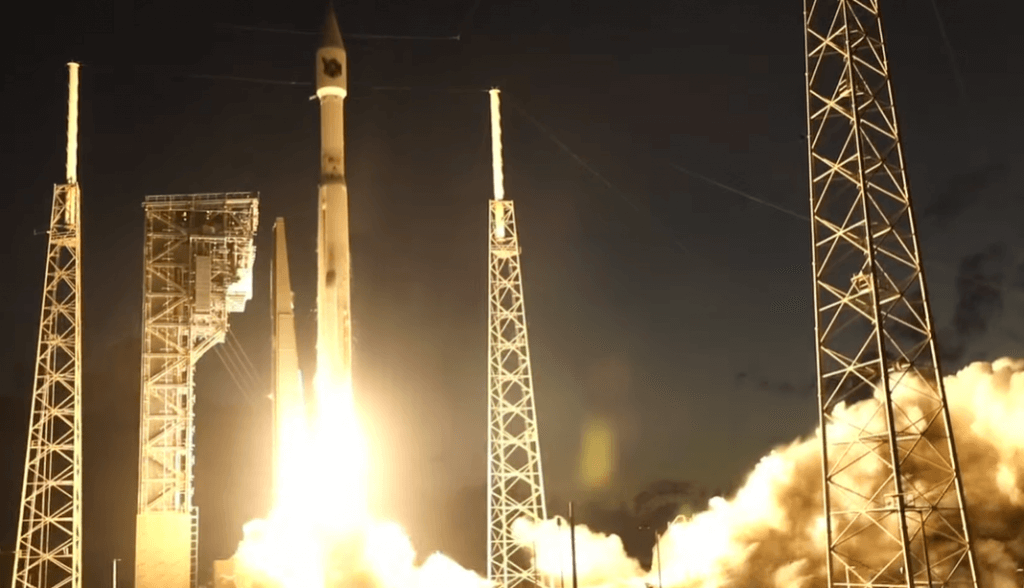The United States’ missile-tracking capabilities are about to get a boost.
United Launch Alliance (ULA) launched the sixth Space Based Infrared System Geosynchronous Earth Orbit (SBIRS GEO-6) satellite this morning (Aug. 4), completing the SBIRS GEO constellation for the U.S. Space Force‘s Space Systems Command (SSC).
An Atlas V rocket carrying the missile-detection satellite lifted off at 6:29 a.m. EDT (1029 GMT) today from Florida’s Cape Canaveral Space Force Station. The rocket’s two stages separated a little over four minutes into flight, setting up the Centaur upper stage with SBIRS GEO-6 for a series of engine burns.
If all goes according to plan, those burns will wrap up about three hours after liftoff. Shortly thereafter, the Centaur will deploy SBIRS GEO-6 into orbit.
Related: The most dangerous space weapons of all time
SBIRS GEO-6 will join five other satellites, completing a ballistic-missile-tracking constellation in geostationary orbit, about 22,200 miles (35,700 kilometers) above Earth, that can detect threats across the globe. Each SBIRS GEO satellite sits in a different spot, allowing broad coverage of the globe.
SBIRS GEO-6’s launch closes the final gap in the satellite chain and brings an end to the development phase of the SBIRS program. The newly lofted satellite’s array of observing tech will provide “infrared surveillance to support missile warning, missile defense, battlespace awareness and technical intelligence,” according to an SSC press release (opens in new tab). (That “infrared surveillance” involves noticing the heat signatures generated by missile exhaust.)
SBIRS GEO-6 was built by aerospace and defense contractor Lockheed Martin, using the company’s LM 2100 Combat Bus. SBIRS GEO-5, which launched in May 2021, was also built on the LM 2100 platform but is the only other satellite in the constellation with that particular upgrade. The LM 2100 Combat Bus stands just over 12 feet (3.7 meters) tall and offers SBIRS GEO-5 and 6 enhanced electronics, maneuverability, surveillance capabilities and more, SSC officials said.
Col. Daniel Walter, senior materiel leader for SSC’s Strategic Missile Warning Acquisition Delta, detailed some of the satellite’s capabilities. “SBIRS satellites are the first line of defense, providing early warning, launch detection, and notifications to national leaders and theater warfighters,” he said in the release.
SBIRS GEO-1 launched in 2011, followed by the rest of its company between 2013 and 2021. While SBIRS GEO-6 brings this launch series to an end, technology for the SSC’s next-generation missile detection system has already started development.
Known as the Next Generation Overhead Persistent Infrared (Next-Gen OPIR) Geosynchronous Earth Orbit system, the overhauled weapons-tracking satellite platform is being designed to initially enhance, and eventually replace, the SBIRS GEO constellation.
In addition to its predecessors’ capabilities, Next-Gen OPIR will be able to warn against “counter-space and emerging missile threats,” the SSC press release read. This includes highly maneuverable hypersonic weapons like the Kinzhal missile announced by Russian state media in 2018, which can purportedly travel five times faster than the speed of sound.
An Atlas V launched the Wide Field of View (WFOV) satellite for the Space Force last month. WFOV is serving as the first orbital testbed for Next-Gen OPIR and is expected to remain in operation until the first OPIR program satellite reaches orbit, currently targeted for sometime in 2025.
Follow us on Twitter @Spacedotcom (opens in new tab) or on Facebook (opens in new tab).

